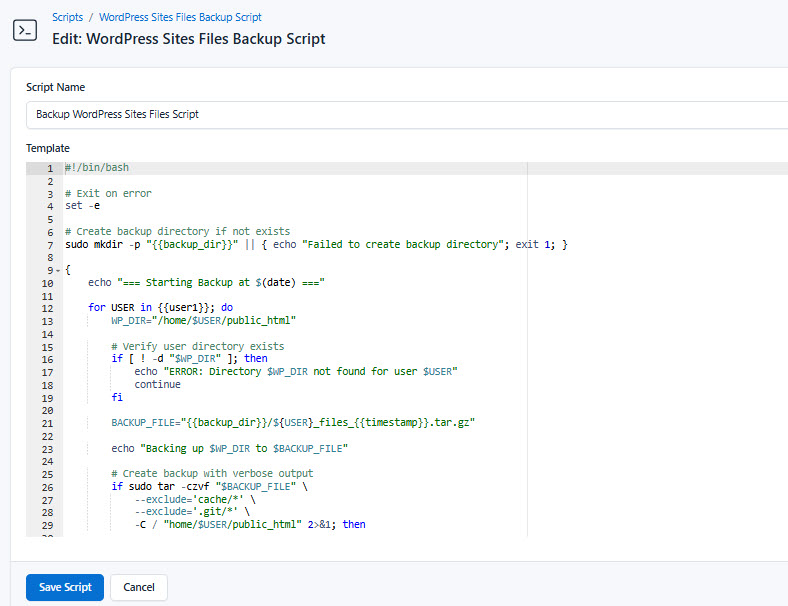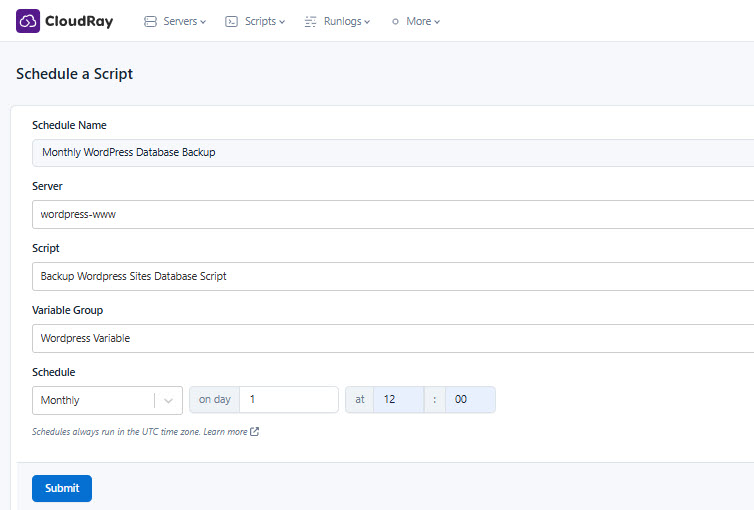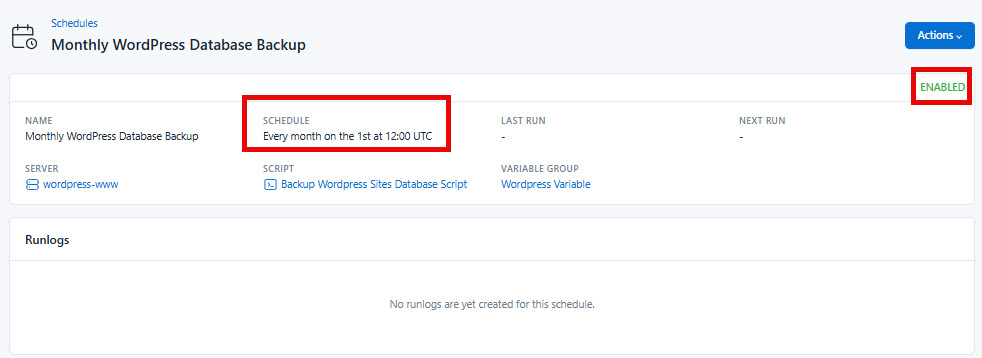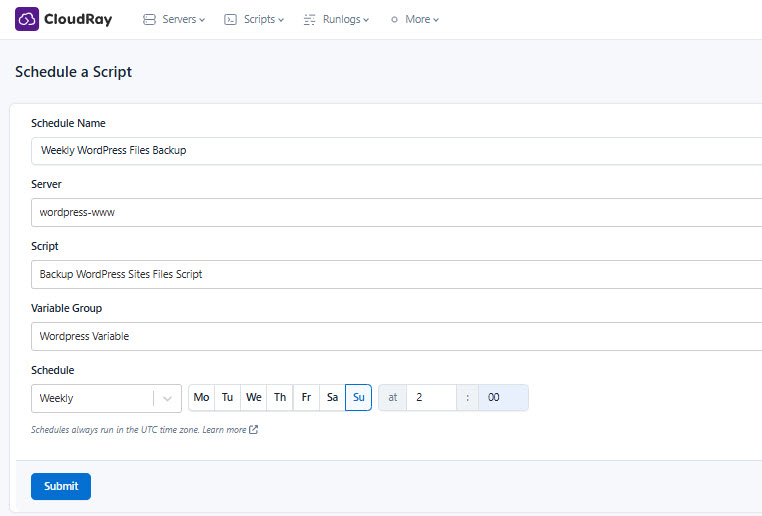How to Automate WordPress Multi-Site Backups
This guide demonstrates how to implement an automated WordPress backup solution for enterprise-grade protection using CloudRay. You will learn how to create isolated backups for WordPress sites (files and database), implement retention policies to manage storage usage, and schedule automated backups using CloudRay’s Schedules feature.
IMPORTANT
Before implementing these backup solutions, ensure you have multiple WordPress sites deployed with isolated users and databases. If you haven’t set this up yet, follow our comprehensive guide on Deploy Multiple WordPress Sites on One Server.
Contents
- Adding Servers to CloudRay
- Create Backup Scripts
- Create a Variable Group
- How to Schedule Automated WordPress Backups for Databases
- How to Schedule Automated WordPress Backups for Filesystem
Adding Servers to CloudRay
Before getting started with your automation, make sure your target servers are connected to CloudRay. If you haven’t done this yet, follow our servers docs to add and manage your server
NOTE
This guide uses Bash scripts, providing a high degree of customisation. You can adapt the scripts to fit your specific installation needs and environment. Additionally, if you’re using a different version or a different distribution, adjust the commands accordingly.
Create Backup Scripts
To fully protect your WordPress multi-site installation, you can implement two specialised backup solutions. The Backup WordPress Sites Database Script securely exports all database content with transaction consistency, while the Backup WordPress Sites Files Script preserves your complete file structure including themes, plugins, and uploads.
To automate Backups, you will need two bash scripts:
- Backup WordPress Sites Database Script: This script creates compressed, transaction-safe exports of each WordPress database while verifying data integrity and maintaining proper user isolation
- Backup WordPress Sites Files Script: This script archives all critical WordPress files while excluding temporary data, with built-in verification to ensure backup reliability
These WordPress backup scripts solve critical challenges for multi-site administrators by providing:
- Scheduled WordPress backups that run without manual intervention
- Secure WordPress backups with integrity verification
- A complete WordPress backup solution covering both database and files
Backup WordPress Sites Database Script
To create your automated database backup script in CloudRay, follow these steps to create the script that will protect your WordPress site critical data:

- Go to Scripts → New Script
- Name it
Backup WordPress Sites Database Script - Add the following script:
#!/bin/bash
# Exit on error
set -e
# Create backup directory if not exists
sudo mkdir -p "{{backup_dir}}" || { echo "Failed to create backup directory"; exit 1; }
{
echo "=== Starting Database Backup at $(date) ==="
echo "Host: $(hostname)"
echo "MySQL Version: $(mysql --version)"
# Verify MySQL connectivity
if ! mysql -u "{{db_user1}}" -p"{{db_pass1}}" -e "SHOW DATABASES;" >/dev/null 2>&1; then
echo "ERROR: Cannot connect to MySQL server"
exit 1
fi
# Backup first WordPress database
echo "Backing up database {{db1}} to {{backup_dir}}/{{db1}}_db_{{timestamp}}.sql.gz"
if mysqldump --single-transaction --quick \
-u "{{db_user1}}" -p"{{db_pass1}}" "{{db1}}" \
| gzip > "{{backup_dir}}/{{db1}}_db_{{timestamp}}.sql.gz"; then
if gzip -t "{{backup_dir}}/{{db1}}_db_{{timestamp}}.sql.gz"; then
echo "SUCCESS: {{db1}} backup (Size: $(du -h "{{backup_dir}}/{{db1}}_db_{{timestamp}}.sql.gz" | cut -f1))"
zgrep -q "wp_options" "{{backup_dir}}/{{db1}}_db_{{timestamp}}.sql.gz" || echo "WARNING: Missing WordPress tables in {{db1}} backup"
else
echo "ERROR: Backup verification failed for {{db1}}"
sudo rm -f "{{backup_dir}}/{{db1}}_db_{{timestamp}}.sql.gz"
fi
else
echo "ERROR: Database backup failed for {{db1}}"
fi
# Apply retention policy
echo "Cleaning up backups older than {{retention_days}} days..."
find "{{backup_dir}}" -name "*_db_*.sql.gz" -mtime +{{retention_days}} -delete
echo "=== Database Backup Completed at $(date) ==="
echo "Remaining backups:"
ls -lh "{{backup_dir}}"/*_db_*.sql.gz 2>/dev/null || echo "No database backups found"
echo "Disk usage: $(df -h {{backup_dir}})"
} | tee -a "{{db_log_file}}"Here is a breakdown of what the Backup WordPress Sites Database Script does:
- Creates transaction-consistent backups using
mysqldump --single-transactionto avoid database locking during backups - Compresses database dumps with
gzipto minimise storage usage while maintaining data integrity - Verifies backup completeness by checking for essential WordPress tables like wp_options
- Implements automatic retention by deleting backups older than the specified number of days
- Provides detailed logging with timestamps, success/failure status, and backup sizes
- Validates MySQL connectivity before attempting backups to prevent partial failures
- Maintains isolated backups for each WordPress site according to your multi-site architecture
- Includes corruption checks using
gzip -tto automatically detect and remove invalid backups
Backup WordPress Sites Files Script
Similarly, to create your automated WordPress files backup script in CloudRay, follow these steps to create the script:

- Go to Scripts → New Script
- Name it
Backup WordPress Sites Files Script - Add the following script:
#!/bin/bash
# Exit on error
set -e
# Create backup directory if not exists
sudo mkdir -p "{{backup_dir}}" || { echo "Failed to create backup directory"; exit 1; }
{
echo "=== Starting Backup at $(date) ==="
for USER in {{user1}}; do
WP_DIR="/home/$USER/public_html"
# Verify user directory exists
if [ ! -d "$WP_DIR" ]; then
echo "ERROR: Directory $WP_DIR not found for user $USER"
continue
fi
BACKUP_FILE="{{backup_dir}}/${USER}_files_{{timestamp}}.tar.gz"
echo "Backing up $WP_DIR to $BACKUP_FILE"
# Create backup with verbose output
if sudo tar -czvf "$BACKUP_FILE" \
--exclude='cache/*' \
--exclude='.git/*' \
-C / "home/$USER/public_html" 2>&1; then
# Verify backup integrity
if sudo gzip -t "$BACKUP_FILE"; then
echo "SUCCESS: Backup created for $USER (Size: $(du -h "$BACKUP_FILE" | cut -f1))"
else
echo "ERROR: Backup verification failed for $USER"
sudo rm -f "$BACKUP_FILE"
fi
else
echo "ERROR: Backup failed for $USER"
fi
done
echo "=== Backup completed at $(date) ==="
echo "Disk usage: $(df -h {{backup_dir}})"
} | tee -a "{{log_file}}"Here is a breakdown of what the Backup WordPress Sites Files Script does:
- Creates compressed archives of each WordPress site’s
public_htmldirectory using tar+gzip for efficient storage - Maintains file permissions by running as
sudoto properly backup all WordPress files - Excludes non-essential files like
cacheandgitdirectories to reduce backup size - Verifies backup integrity with
gzip -tto ensure archives are not corrupted - Provides detailed logging including timestamps, file sizes, and success/failure status
- Handles multiple sites by iterating through all configured WordPress users
- Checks directory existence before attempting backups to prevent errors
- Tracks disk usage after completion to monitor storage consumption
- Preserves directory structure using -C flag for proper restoration and outputs verbose progress during archive creation for monitoring
Create a Variable Group
These backup scripts builds on the same variables used in the guide Deploy Multiple WordPress Sites. However, you need to define values for the following placeholders {{backup_dir}}, {{timestamp}}, {{log_file}}, {{db_log_file}}, and {{retention_days}} used in the scrips.
Follow these steps to edit the variable group and include the new variables to ensure that these new values are automatically substituted when the script runs:

- Navigate to Variable Groups: In your CloudRay project, go to “Scripts” in the top menu and click on “Variable Groups”.
- Edit the Variable Group: Click on variable group you created earlier for the WordPress sites and edit it
- Add the following variables:
backup_dir: The central directory of all backupstimestamp: time format for naming the backupslog_file: Filesystem backup logsdb_log_file: Database backup logsretention_days: Auto-delete backups older than X days
Since the variables are setup, proceed to creating backups schedules with CloudRay.
How to Schedule Automated WordPress Backups for Databases
CloudRay offers Schedules, allowing you to execute scripts automatically at specific intervals or times. This feature is useful for tasks such as automating database backups.
For example, if you want to back up your WordPress sites database on the first day of every month at 12:00 AM, you can configure a CloudRay schedule to handle this automatically.
Here are the steps to achieve this:
- Navigate to Schedules: In your CloudRay dashboard, go to the “Schedules” tab.

- Click “Add Schedule”: Start creating a new schedule.

- Submit Schedule: Click “Submit” to activate your new schedule.

CloudRay will automatically execute the backup script at the scheduled time, ensuring that your WordPress sites database is regularly backed up without manual intervention.
How to Schedule Automated WordPress Backups for Filesystem
For comprehensive WordPress protection, you can implementing a weekly filesystem backup schedule alongside your database backups.
For example, if you want to backup your WordPress sites filesystem weekly every sunday at 2:00AM, you can configure a CloudRay schedule. Similarly, here is how to achieve this:
- Click “Add Schedule”: Start creating a new schedule.

- Submit Schedule: Click “Submit” to activate your new schedule.

With this schedule in place, CloudRay will automatically perform weekly backups of your WordPress files every Sunday at 2:00 AM, ensuring your site content remains protected without manual intervention.
TIP
These scripts are designed for easy reuse across multiple WordPress sites. Simply edit the variable group to include additional database credentials (db2, db_user2, etc.) or users (user2, user3) as needed. CloudRay will automatically apply the updated variables when the scheduled backups execute, allowing the same scripts to manage backups for any number of WordPress installations.
Written by Olusegun Durojaye
CloudRay Team